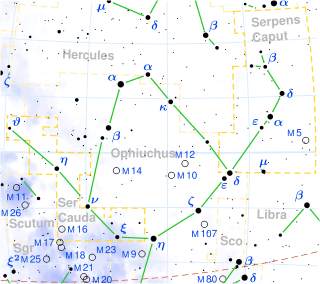Iota Serpentis
 | |
| Observation data Epoch J2000 Equinox J2000 | |
|---|---|
| Constellation | Serpens |
| Right ascension | 15h 41m 33.05469s[1] |
| Declination | 19° 40′ 13.4380″[1] |
| Apparent magnitude (V) | 4.51[2] |
| Characteristics | |
| Spectral type | B9V + A1V[3] |
| B−V color index | +0.06[2] |
| Astrometry | |
| Radial velocity (Rv) | −17.20[4] km/s |
| Proper motion (μ) | RA: -60.86[1] mas/yr Dec.: -43.69[1] mas/yr |
| Parallax (π) | 17.16 ± 0.67[1] mas |
| Distance | 190 ± 7 ly (58 ± 2 pc) |
| Absolute magnitude (MV) | +0.69[5] |
| Orbit[6] | |
| Period (P) | 8015.0 days |
| Semi-major axis (a) | 0.21033″ |
| Eccentricity (e) | 0.0941 |
| Inclination (i) | 83.608° |
| Longitude of the node (Ω) | 69.684° |
| Argument of periastron (ω) (secondary) | 80.5° |
| Details | |
| A | |
| Mass | 1.999[3] M☉ |
| B | |
| Mass | 1.984[3] M☉ |
| Other designations | |
| Database references | |
| SIMBAD | data |
Iota Serpentis, Latinized from ι Serpentis, is a triple star[7] system in the constellation Serpens, in its head (Serpens Caput). It is approximately 190 light years from Earth.[1]
At the centre of the system is a spectroscopic binary, Iota Serpentis A and B. These are both white main sequence dwarfs and both have apparent magnitudes of +5.3. This binary has an orbital period variously reported as 11[8] or 22[6] years. First discovered as an astrometric binary, the pair have now been resolved and visual orbits have been derived.[6]
There are two visual companions, Iota Serpentis C, a 13th magnitude star 143 arcseconds away and Iota Serpentis D, a 12th magnitude star 151 arcseconds distant.
References
- 1 2 3 4 5 6 van Leeuwen, F. (2007). "Validation of the new Hipparcos reduction". Astronomy and Astrophysics. 474 (2): 653–664. arXiv:0708.1752. Bibcode:2007A&A...474..653V. doi:10.1051/0004-6361:20078357. Vizier catalog entry
- 1 2 3 "Iota Serpentis". SIMBAD Astronomical Database. Retrieved 2015-10-17.
- 1 2 3 Martin, C; Mignard, F; Hartkopf, W. I; McAlister, H. A (1998). "Mass determination of astrometric binaries with Hipparcos. III. New results for 28 systems". Astronomy and Astrophysics Supplement. 133 (2): 149. Bibcode:1998A&AS..133..149M. doi:10.1051/aas:1998459.
- ↑ Evans, D. S. (June 20–24, 1966). "The Revision of the General Catalogue of Radial Velocities". In Batten, Alan Henry; Heard, John Frederick. Determination of Radial Velocities and their Applications, Proceedings from IAU Symposium no. 30. Determination of Radial Velocities and their Applications. 30. University of Toronto: International Astronomical Union. p. 57. Bibcode:1967IAUS...30...57E.
- ↑ Anderson, E.; Francis, Ch. (2012), "XHIP: An extended hipparcos compilation", Astronomy Letters, 38 (5): 331, arXiv:1108.4971, Bibcode:2012AstL...38..331A, doi:10.1134/S1063773712050015.
- 1 2 3 Muterspaugh, Matthew W.; et al. (2010). "The Phases Differential Astrometry Data Archive. II. Updated Binary Star Orbits and a Long Period Eclipsing Binary". The Astronomical Journal. 140 (6): 1623–1630. arXiv:1010.4043. Bibcode:2010AJ....140.1623M. doi:10.1088/0004-6256/140/6/1623.
- ↑ Eggleton, P. P.; Tokovinin, A. A. (September 2008), "A catalogue of multiplicity among bright stellar systems", Monthly Notices of the Royal Astronomical Society, 389 (2): 869–879, arXiv:0806.2878, Bibcode:2008MNRAS.389..869E, doi:10.1111/j.1365-2966.2008.13596.x.
- ↑ van den Bos, W. H. (1965). "Note on the Double Star Iota Serpentis". Monthly Notes of the Astronomical Society of Southern Africa. 24: 123. Bibcode:1965MNSSA..24..123V.
This article is issued from
Wikipedia.
The text is licensed under Creative Commons - Attribution - Sharealike.
Additional terms may apply for the media files.